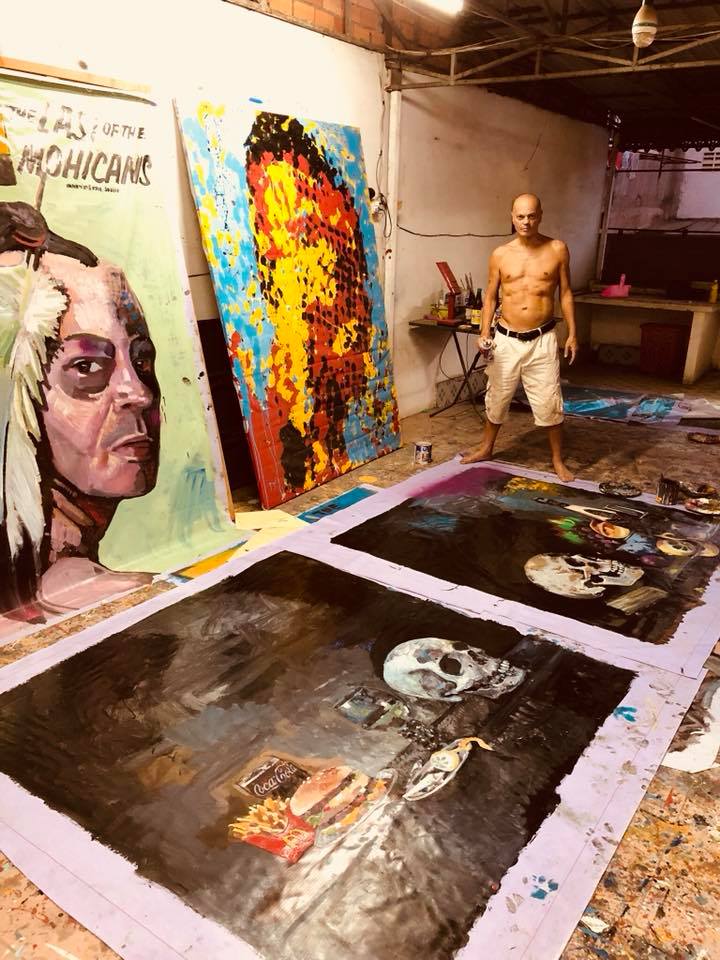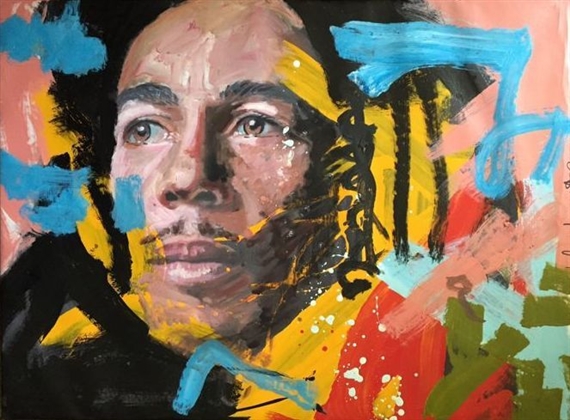
I’ve been mentally taking notes for a Peter Klashorst profile for years. I haven’t had writers block so much as a dam of ideas broken open to a torrent of thoughts making it hard to decide which stream of consciousness to follow? Klashorst as artistic genius is the easy choice. There are many others from which to choose. For those unfamiliar with the Dutch painter who in the 1980s became one of the leading personalities of a European art movement named “The New Wild Ones” I hope to introduce a small part of him to you. For those of you who know Peter better than I, my goal is to weave a partial portrayal of him that will be worth reading. I’m not adverse to seeking advice when I find myself in deep water so I asked a writer-friend how he would describe Peter. “That’s like asking a blind man to describe an elephant”, he replied. That pretty much describes the task at hand for me. I asked another man of accomplishment to describe Peter in three words. My assumption was I’d get back three adjectives. There are thousands applicable to Peter. Instead he returned, “A train wreck.” That response caught me by surprise yet I understood how the phrase applied instantly. Peter Klashorst would be a difficult person to come across without taking a longer look. He’s a physically small man with a big heart and a steam engine of a libido, when he’s healthy, along with carloads of impressive art to his name.
My personal struggle with his profile always came down to a simple question. How do I separate the artist from the art? That seems to be the popular course in the #metoo times of Bill Cosby, Harvey Weinstein, and Woody Allen. Then I read a line on British author John Burdett’s Facebook page that got me on the right track. John wrote about a lifetime observation of his that “…great talent and conventional morality rarely inhabit the same body.” That made me think. A lot. For one, what is “conventional morality”? I’m not sure. But I am reasonably sure that Peter Klashorst’s morality is unconventional. He is also, unequivocally, a great talent. I’m sticking with artistic genius. Let’s define it:
Genius: Very great and rare natural ability or skill, especially in a particular area such as science or art. – Cambridge English Dictionary
How many artistic geniuses with unconventional moralities have you met in your lifetime? I’ve met damn few that I know of. And I think I know why. I’m not always eager to meet them. That was the case for me with Peter. Four friends were heading over on a Sunday evening to meet-up with the painter and I was invited along. I gave it a pass. Pablo Picasso may not have been called an asshole, but I figured Peter likely was one. Anybody that talented must be. So why meet him? Life is short.
A photograph of Peter Klashorst by Robert Mapplethorpe (Image may be subject to copyright)
However, Peter’s art continued to intrigue me. So I decided to buy a Klashorst original. If you are going to be a consumer, as we are taught to be in the USA, you might as well be a creative one. And besides, the price was right.
Peter was once photographed by the famous photographer Robert Mapplethorpe when he was a younger and already a highly established artist well known in the New York City art scene and the larger art world. Peter won the Buning Brongers Award, a biennial Dutch art prize for young artists, which is the biggest private art prize of the Netherlands. In 1983 he received a prestigious Dutch Royal Award from Queen Beatrix. If that doesn’t impress you I heard from a credible source that he was the first choice to do an artistic re-branding of Heineken beer bottles and beer cans until that unconventional morality got involved. None of this information was known to me at the time I met Peter in December of 2015 at Hemingway’s Bangkok to conclude my purchase. I just knew he was good at what he did. You don’t need to be an art expert to figure that out.
Peter arrived wearing flip flops, jeans rolled up with self made three inch cuffs, a denim collared shirt untucked, no jewelry or watch, and a pale white chrome dome. His body was smaller than I had visualized but nothing else about him or his personality was diminutive. References provided upon request.
Peter Klashorst on the balcony of his Phnom Penh Studio with large painting
We sat down and ordered reasonably good food – oysters and sushi. It was the afternoon so Peter drank water as we ate and talked. The alcohol comes later, at night, he told me. Peter is immediately likable. That caught me off guard. I’m convinced that had art not been his calling he would have made a fine Bentley car salesman on Wilshire Blvd in Los Angeles. First Round draft choices of the Lakers or Clippers and the rich and famous would all find Peter’s charm and selling ability genuine. Like his art it wouldn’t be a question of whether you are going to buy from Peter but which one? Peter would hate that job, of course, as he would any conventional job. To my knowledge, artist is the only occupation he’s ever known. Lucky guy. There is no pretense with Klashorst. What you see is what you get and truth is what you will hear. Unfiltered truth. He’s a rare bird in that he doesn’t come across like he’s all that but he is all that. Peter took ample interest in me too (no hash tag). Bonus points.
With Peter was the painting he had completed from a smaller study he had posted online. It was a painting of his home and studio on Street 130 in Phnom Penh, Cambodia. The work was inspired by a painting completed in 1888 by another Dutch painter, Vincent Van Gough. Titled The Street by Vincent but better known to art lovers as The Yellow House. Both paintings depict the artists immediate surroundings and the place where much of their art was/is produced. I liked the painting straight away from the study, but what Peter brought was considerably more detailed. It was much better than I had hoped for. I was as happy as any material item can make a person happy. I would later learn that in October of 2014 Peter had an exhibition of his art shown at his home depicted in the painting, named appropriately, Lust for Life.
Peter Klashorst with a painting I call, The Yellow Studio or Street 130
It is Peter’s lust for life that makes me now realize you cannot and should not separate the artist from the art. It is a continuum. Peter is the art and the art is Peter. You can’t have one without the other and the world is a more interesting place because of each. A more recent exhibition of Peter’s art was held in Bangkok called Cunt and Cock Show held at Rebel Art Space. It featured, well, must I paint you a picture? Peter painted plenty. Themes found in Klashorst paintings range from the erotic, irony, death, power, absurdity, humor, politics, Disney characters, Super Heroes, paradox, junk food, society – high and low – or any combination of these.
Painting is a very personal experience. As Peter commented in an interview with the Phnom Penh Post a few years ago, “It’s like showing yourself totally naked and it’s terrible. You cannot run away.” It’s often said that art speaks to us. Peter’s art has a large vocabulary – some of it obscenity laced. What you hear and see will depend on your own eyes, ears, and mind. My mind tells me that Peter is a brilliant portrait artist. In reality he’s brilliant at whatever art he attempts, I just prefer some brilliance over others. So, too, does Facebook. Peter has been banned multiple times, not long ago for depicting Mickey Mouse in a sexually explicit pose with a grown woman. Facebook, in its infinite wisdom, deemed that Mickey was a child and thus Peter had depicted child pornography as art. Peter countered with an offensive that he had a copy of Mickey’s Identification proving the mouse was a man. Considering that Mickey was conceived in a garage by Walt Disney in 1927 I liked Peter’s chances in a court of law. But Facebook dispenses with those formalities – they are the new sheriff in town and Peter is Otis on the old Andy of Mayberry Show, the likeable imbiber always doing short-time.
Portait of Bob Marley by Peter Klashorst
Female Fighter in Columbian jungle by Peter Klashorst
Small Study of Man in Foodland by Peter Klashorst. He speaks to me.
Portrait of a Young Woman by Peter Klashorst
Peter Klashorst Self Portrait – Last of the Mohicans
There are legitimate reasons for people to want to discuss the unconventional morality of Klashorst in more detail. His trials and tribulations with HIV and the health complications that followed due to his voluntary decision to stop taking health-benefiting medications for periods of time are well documented. Read his Wikipedia page for starters. Decisions have consequences as a Yale Law School lawyer once told me. I have gone from not liking Peter Klashorst before I ever met him, to liking him a great deal, to questioning his judgment, to hoping he likes me. And none of that matters. Yes, decisions do have consequences and Peter Klashorst makes those decisions every single day. He decides to paint and engage his talent on his own terms as an act of free will. He decides to live. He will die another day. Those decisions are far reaching and long lasting. He is the embodiment of what it means to be an artist in this century or any century past. He’s not the last of the Mohicans, he’s still a new wild one.
At the conclusion of my two hour meeting with Peter at Hemingway’s I was impressed with his demeanor and stories, so I told him, “Someone should write a biography about you.” Peter replied, matter-of-factly, “Oh, they have.”
Of course they have, I remember thinking. Of course they have.
A YouTube video of Peter’s Art Exhibition, Die Another Day
You can follow Peter on Twitter @KlashorstPeter or inquire about his art on Facebook when he’s not banned at https://www.facebook.com/klashorst









2 Responses to “Long Live King Klashorst … Long Live the King – A Profile of Dutch Painter Peter Klashorst”
Very good description of this inspired man called Peter Klapworst
Thanks. I think.